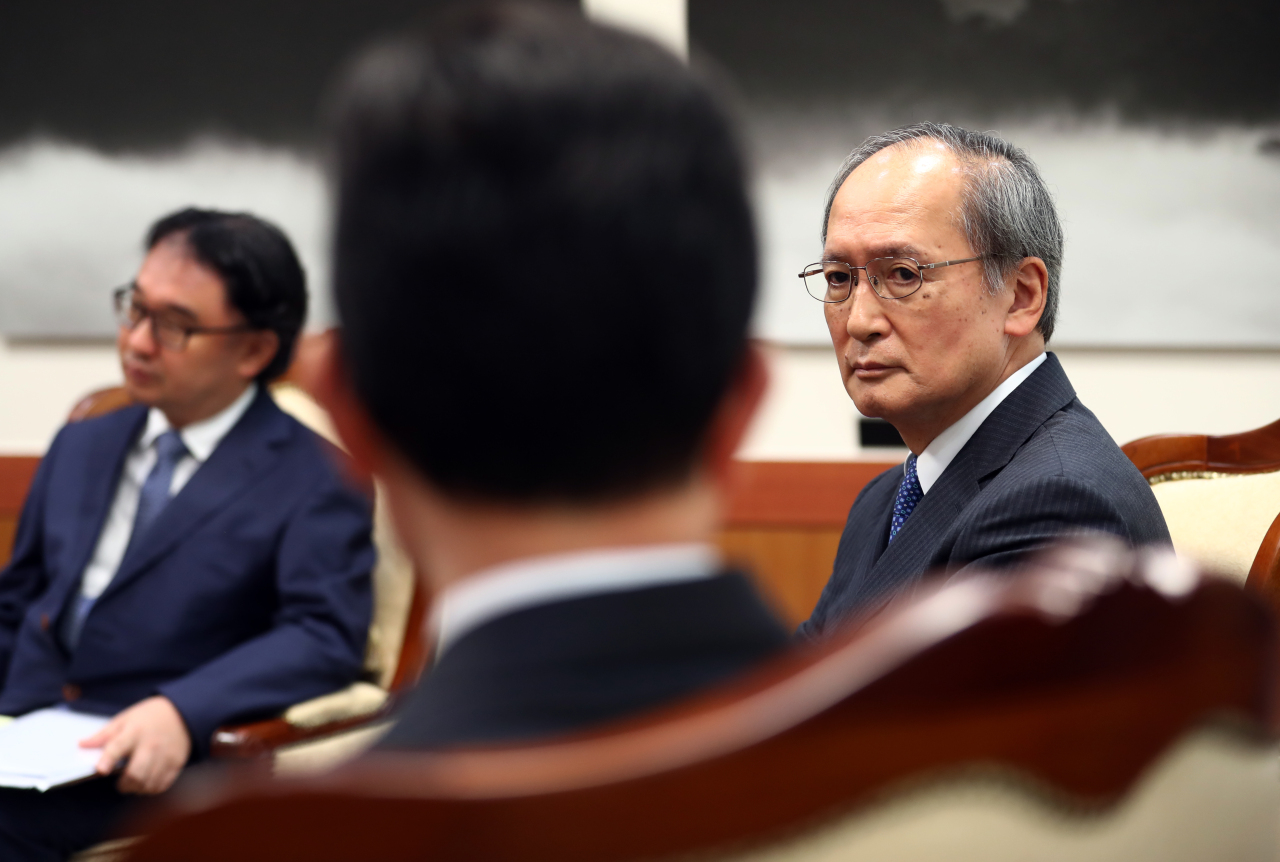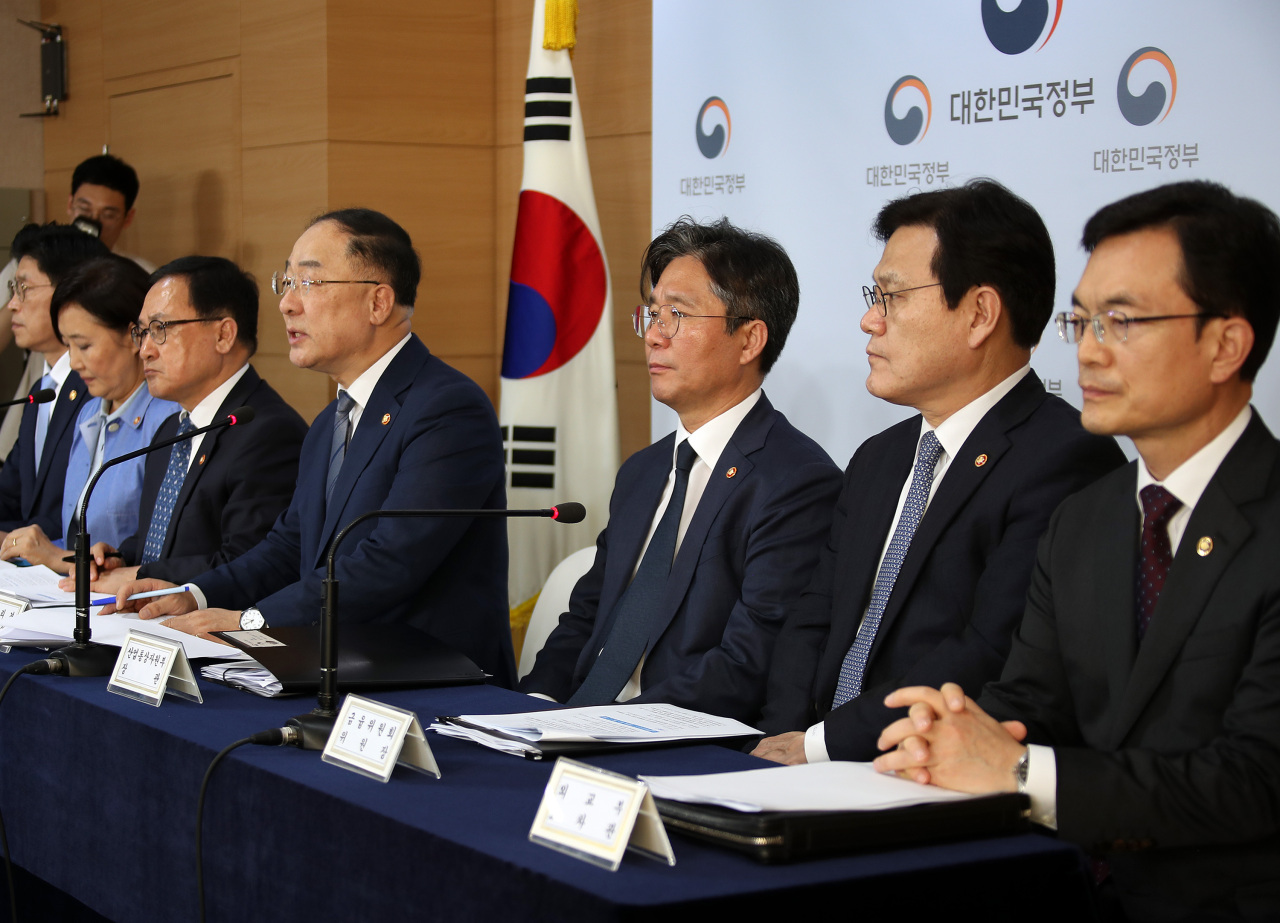[Anniversary Special] ‘Japan’s export curbs hint at changing Seoul-Tokyo trade model’
Experts decode 54 years of trade ties with Japan, highlighting how South Korea’s economic growth is affecting the dynamics from vertical to horizontal
By Jung Min-kyungPublished : Aug. 14, 2019 - 15:46
Japan’s decision to remove South Korea from its list of trusted export partners in late July brought the relations between the two neighboring countries to a new low.
Tensions stemming from the bilateral trade row served as a stark reminder that old wounds run deep and both sides will always have to deal with their complicated histories marked by the 1910-45 Japanese colonial rule of Korea.
But according to local experts, the latest dispute is also a sign of changing trade dynamics between the two countries, after Seoul and Tokyo began trading upon normalizing ties in 1965.
The relationship is shifting from the previous vertical trade model, between a developed and a developing country, to a more horizontal one, where countries with similar economic level trade in similar products -- resulting in Tokyo’s heightened sensitivity to South Korea’s economic growth.
Tensions stemming from the bilateral trade row served as a stark reminder that old wounds run deep and both sides will always have to deal with their complicated histories marked by the 1910-45 Japanese colonial rule of Korea.
But according to local experts, the latest dispute is also a sign of changing trade dynamics between the two countries, after Seoul and Tokyo began trading upon normalizing ties in 1965.
The relationship is shifting from the previous vertical trade model, between a developed and a developing country, to a more horizontal one, where countries with similar economic level trade in similar products -- resulting in Tokyo’s heightened sensitivity to South Korea’s economic growth.

“Japan’s latest trade move, which is to tighten exports of key materials needed in manufacturing semiconductors and displays, is a sign that the Seoul-Tokyo trade relations are shifting from the previous vertical relationship to a horizontal one,” Kim Gyu-pan, a researcher at the state-run Korea Institute for International Economic Policy said.
“This is perhaps Tokyo’s strongest sanctions and expression tied to trade ever seen in the history of trade relations with Seoul.”
After Japan’s economic bubble burst in the 1990s, the country’s manufacturing sector acted as a pillar for its economy. But after 2000, its manufacturing and electronics sector began to decline, while South Korean firms began to expand presence in the global market, Kim explained.
Echoing Kim’s remarks, several news outlets, including BBC, ran articles in the early 2010s dissecting the fall of Japanese electronics giants that once dominated the global market, such as Sony, Panasonic, and Sharp.
A BBC article released in April 2013 cited the digital revolution as being behind the fall, as well as changes in the manufacturing model for global electronics firms, which moved production to low-cost countries, putting huge pressure on Japanese manufacturers’ profit margins. “Today it is Apple and Samsung that dominate, even here on Sony’s home ground,” the article noted.
As South Korean household names such as Samsung and LG continue to break new ground, Seoul’s growing efforts to cut its decades-old trade reliance on Japanese imports, is apparently a concern for Tokyo as well.
South Korea has never had a trade surplus with Japan since normalizing ties in the 1960s, indicating Seoul’s heavy reliance on Japanese imports. It has notched up a total trade deficit of over $600 billion with Japan, over the past 54-years, according to the Korea International Trade Association in July.
In 2018, the trade deficit with Japan was $24 billion, higher than its deficits with Saudi Arabia, Qatar, Kuwait, which mainly export oil to South Korea.
But this in turn, means that Japan has run a perennial trade surplus with South Korea, at $20.3 billion in 2018, with parts, chemicals and other materials and equipment accounting for about $15 billion of its exports last year, according to data provided by AP earlier this month.
Japan’s trade surplus is tied to South Korea’s economic growth, considered one of the greatest success stories in modern history -- a transformation into one of the world’s richest economies in just decades after colonialism and the 1950-53 Korean War.
“The only option for South Korea to achieve economic growth after the Korean War was to turn to light industry, which produces smaller consumer goods or raw materials, but this sparked a chronic trade deficit with Japan, which would continue for decades,” Heo Yoon, a professor at Sogang University’s Graduate School of International Studies told The Korea Herald.
“The more we manufactured and exported goods, the more we had to bring in the necessary parts and materials from Japan.”
“The South Korean government’s efforts to minimize reliance on Japanese imports date back to the 1980s, when Seoul started to realize the importance of investment in local materials, parts, and equipment. Such efforts are not a recent movement, it’s something that has been culminating and gaining momentum for decades.”
South Korea recently announced plans to invest about $6.48 billion in research and development for local materials, parts and equipment over the next seven years, in a bid to further reduce its reliance on Japan.
“It’s important for Seoul and Tokyo to always keep in mind that it’s a ‘global supply chain,’ nowadays, which means, in a nutshell, what goes around comes around,” Heo added, referring to the potential negative consequences for countries that impose trade sanctions.
Seoul-Beijing-Tokyo FTA
The three major economies of Northeast Asia -- South Korea, China, and Japan -- have been engaged in talks about a trilateral free-trade agreement for nearly six years.
Onlookers have hoped that the FTA would deepen economic cooperation among the three, and work as a device that could alleviate tensions during disputes – like the latest trade row between Seoul and Tokyo.

However, experts hold divided opinions that the trilateral FTA will be reached, due to the parties’ diverging interests, differences in their economic and trade structures and deep historical wounds.
“An FTA aims to eliminate trade barriers based on trust, and I’m afraid the level of trust among the three parties is not sufficient for the agreement to materialize,” said Heo.
“The lack of trust can be observed in China’s economic retaliation against South Korea in 2007 for Seoul’s decision to deploy the terminal high altitude area defense anti-missile system. There has been no solid progress in the talks whatsoever.”
Moreover, the talks of South Korea-Japan FTA in 2006 failed to materialize, while the South Korea-China FTA signed in 2016, is often criticized as a “low-level” agreement.
But there are still hopes that the three will overcome their differences to create a powerful alliance that would help them counter risks stemming from an economic slowdown.
“The trilateral FTA would reduce the risk of disruption of the global free trade system, by keeping the respective parties under a pact,” Kim said.
By Jung Min-kyung (mkjung@heraldcorp.com)







![[Graphic News] More Koreans say they plan long-distance trips this year](http://res.heraldm.com/phpwas/restmb_idxmake.php?idx=644&simg=/content/image/2024/04/17/20240417050828_0.gif&u=)
![[KH Explains] Hyundai's full hybrid edge to pay off amid slow transition to pure EVs](http://res.heraldm.com/phpwas/restmb_idxmake.php?idx=644&simg=/content/image/2024/04/18/20240418050645_0.jpg&u=20240419100350)






![[From the Scene] Monks, Buddhists hail return of remains of Buddhas](http://res.heraldm.com/phpwas/restmb_idxmake.php?idx=652&simg=/content/image/2024/04/19/20240419050617_0.jpg&u=20240419175937)

![[KH Explains] Hyundai's full hybrid edge to pay off amid slow transition to pure EVs](http://res.heraldm.com/phpwas/restmb_idxmake.php?idx=652&simg=/content/image/2024/04/18/20240418050645_0.jpg&u=20240419100350)

![[Today’s K-pop] Illit drops debut single remix](http://res.heraldm.com/phpwas/restmb_idxmake.php?idx=642&simg=/content/image/2024/04/19/20240419050612_0.jpg&u=)